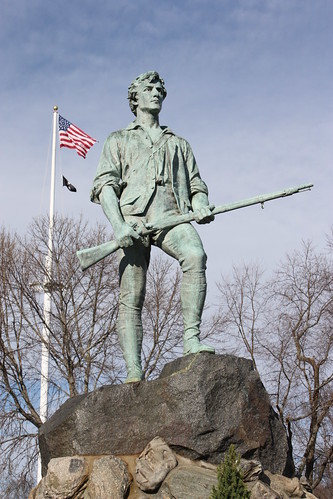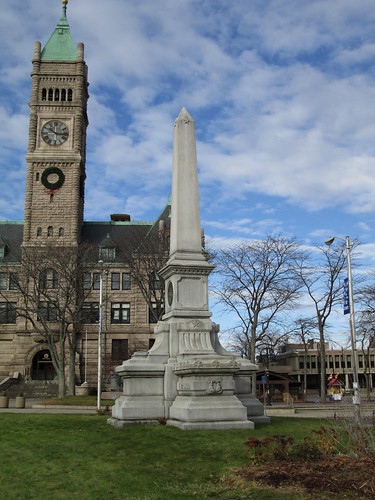Bunker Hill Day & The Ladd & Whitney Monument

Minuteman Statue, Lexington Green
Today is the 240th anniversary of the Battle of Bunker Hill. The battle is noteworthy because it was the first major engagement between the colonial militia and the British troops. Eight weeks earlier, an intense fight had occurred at Lexington, Concord and on the route back to Boston, but while those who participated in that engagement knew it was real combat, others – particularly many in England and those in the southern American colonies – viewed the April 19, 1775 episode as an unfortunate accident. Relations between England and the American colonies they believed could still be salvaged. After Bunker Hill, however, with its heavy casualties on both sides and the demonstrated willingness of the Americans to fight the British in a classic battle setting, the point of no return was passed and everyone became committed to an all-out war.
Although Lowell did not exist in 1775 (it was then a sparsely settled section of East Chelmsford), the city did develop an eerie connection to both of the iconic dates of the opening year of the Revolutionary War, April 19 and June 17.
In the spring of 1861, just hours after learning that the South Carolina militia had attacked Fort Sumter, President Abraham Lincoln called for 75,000 volunteers from the northern states to come south to suppress the rebellion. Because of the foresight of Governor John Andrew and Lowell’s Benjamin Butler (a general of the Volunteers) the Massachusetts troops were well organized, well equipped, and ready to leave on short notice.
The train carrying the regiment left Lowell on April 17, 1861, just two days after the surrender of Fort Sumter. Because Washington, DC, was garrisoned by only six companies of regular troops and fifteen companies of local militia whose pro-Southern sentiments made them more of a threat than an asset, the Sixth Regiment was ordered to proceed to the capital as quickly as possible.
The quickest route to Washington led through New York, Philadelphia, and Baltimore, a city with extensive economic, social, and cultural ties to the south. The configuration of the rail route through Baltimore heightened the risk of confrontation. Trains coming from the north arrived at the President Street Station. Individual cars were then decoupled and drawn by horse a mile through the city to Camden Station (adjacent to the current Camden Yards baseball stadium). There, the cars would be reunited with a locomotive and continue the journey southward.
Upon his arrival in Philadelphia, Pennsylvania, at 5:00 P.M. on April 18, Colonel Edward F. Jones, the commander of the Sixth Regiment, learned of the likelihood of violence in Baltimore and formulated a plan designed to avoid confrontation. Rather than remain the night in Philadelphia, the regiment would depart at 1:00 A.M., placing it in Baltimore at first light, when the troublemakers would still be asleep. Once there, the entire unit would dismount from the train and quickly march through the city to Camden Station. The logic of the plan was clear since an entire regiment would likely intimidate any mob that appeared.

Depiction of Baltimore Riot displayed at Massachusetts State House
The plan went awry before the troops even reached Baltimore. Crossing from Delaware into Maryland, the ten cars of the train were floated across the Susquehanna River by ferry. Although Colonel Jones failed to realize it at the time, the cars were reattached to the locomotive in a different order, leaving Jones in the fourth car of the train, not the first. When the train finally arrived in Baltimore, the railroad workers immediately began shuttling individual cars through the city. By the time Jones realized what was happening, his unit was scattered throughout Baltimore, and all he could do was wait and hope that the cars all reached Camden Station intact. The first seven cars did just that, but their passage had alerted city residents who took to the street, blocking the way of the final three cars. A captain took command of the troops in those cars, got them off the train and led them through the streets and the ever-growing crowd. Bricks and then bullets soon followed the insults of the crowd. Four soldiers were killed; thirty-one were wounded. The men of the Sixth returned fire, killing twelve and wounding an untold number of civilians. After reaching the relative safety of Camden Station, the regiment reformed and continued on to Washington where its men were welcomed as heroes and housed in the Senate chamber.
The riot in Baltimore gave the Sixth Massachusetts an early prominence that was eclipsed by the enormous scope of the war and that regiment’s limited participation in it. At the time, however, Ladd, Whitney, Taylor and Needham were seen as “the first martyrs of the great rebellion” and provided the North with symbols to rally around.

Ladd & Whitney Monument, Lowell Mass
Determined to honor the sacrifice of Ladd and Whitney, the people of Lowell constructed a monument in their honor while the Civil War still raged. The monument was to be dedicated on April 19, 1865, the anniversary of the action that claimed their lives. But fate intervened when just a few days earlier, President Lincoln was assassinated. The Lowell monument dedication ceremony was postponed. The choice for the new dedication date – June 17, 1865 – the anniversary of the Battle of Bunker Hill, a holiday still sincerely celebrated by the people of Massachusetts.
Excellent storytelling. You are quite the historian. Your site is fascinating. I’m sure your tours are quite compelling. I’ll have to go on a walking tour the next time I’m in town. Lowell has such an interesting history. During the days of NC6, we never lacked stories to tell. This one is of particular interest because I recently visited Fort McHenry where an exhibit features the story of The Pratt Street Riot. Bravo. Well done. Marcus Jones
[…] Individuals or groups referenced include James B. Francis, Paul Moody, Kirk Boott, Wang Computer and the Ladd & Whitney Monument. […]
When I was a lad (a long time ago), we were somewhere in Massachusetts on vacation with my Aunt, when out on a wide expanse of overgrown land-almost like a prairie to me, there were five or six solitary graves that we walked to from our campground. One of the graves said the young soldier who lay there had died in the Pratt Street Riot of 19 April, 1861 in my hometown of Baltimore, Maryland and I, being a Civil War crazed fourth or fifth grader felt the ground beneath me shake! The tales of the Baltimore Massacre were so distorted even in the early 1960s (Hell look at our State song till this day), that I’d never known of the 6th Massachusetts’ sacrifices, and as I read and researched I realized that Private Charles Taylor’s remains have never been found ( a researcher from Utah in the early 1900s said his grave in Baltimore, Md. was empty). So now the boy in me still hopes someone had brought him home when his memory was fresh and had laid him to rest on that sweet little prairie, and I ask for any and all good sons and daughters of The Sixth Massachusetts to help me lay a wreath on his grave and give him thanks for giving his life for the Land of the Free!
Any help would be much appreciated! Pat Dentry
Pat:
Where did you read a Researcher in Utah found Taylor’s Grave in Baltimore Empty?
Please advise… PresidentStreetStation@gmail.com